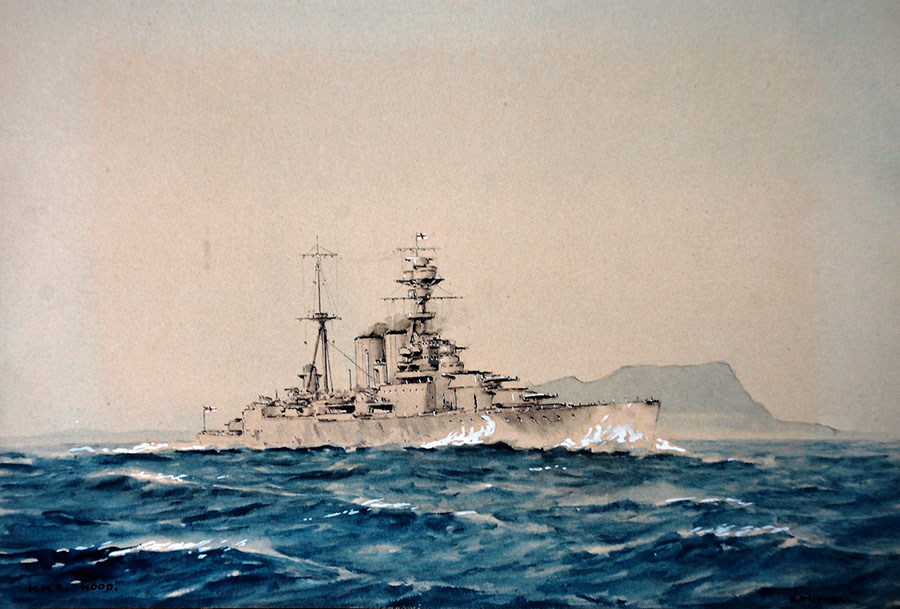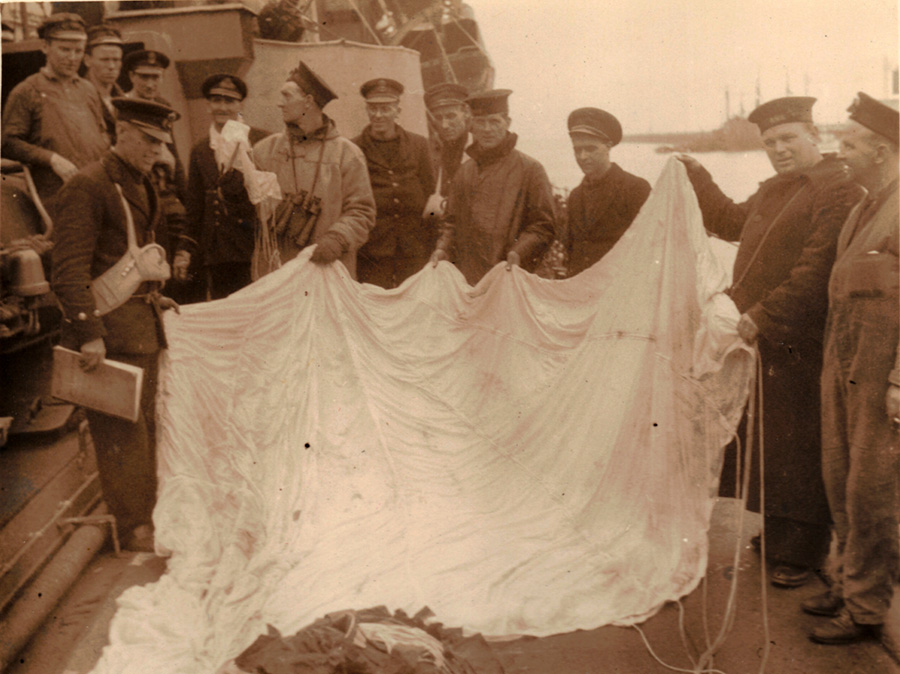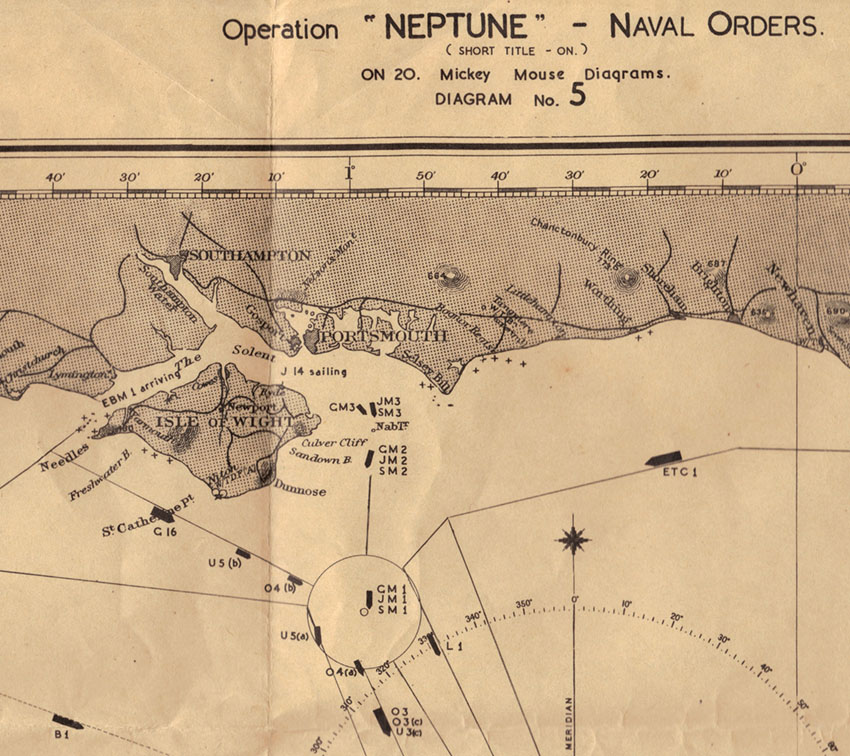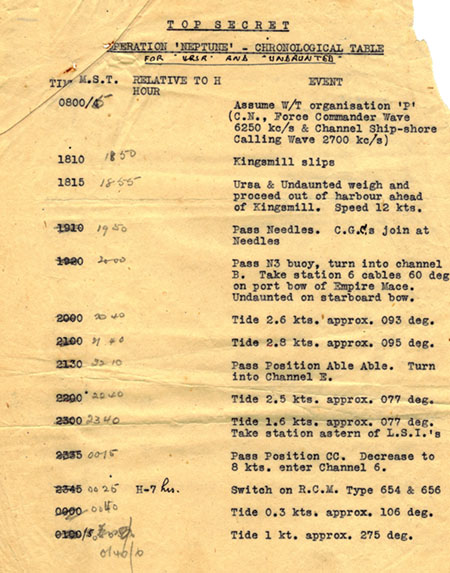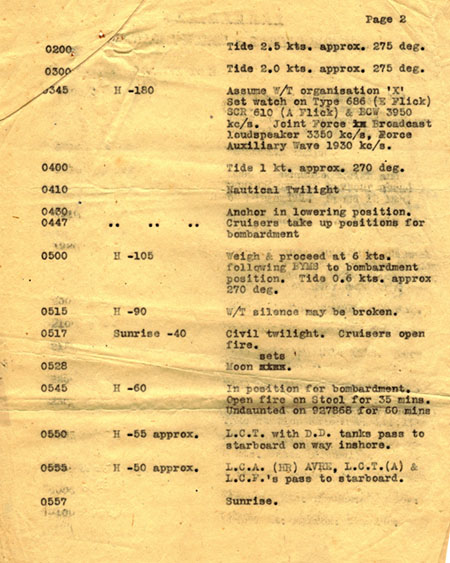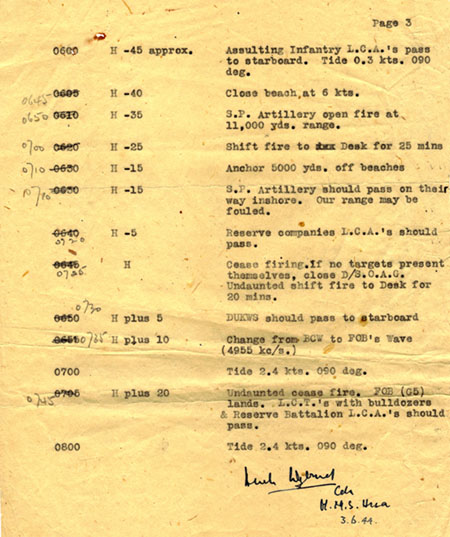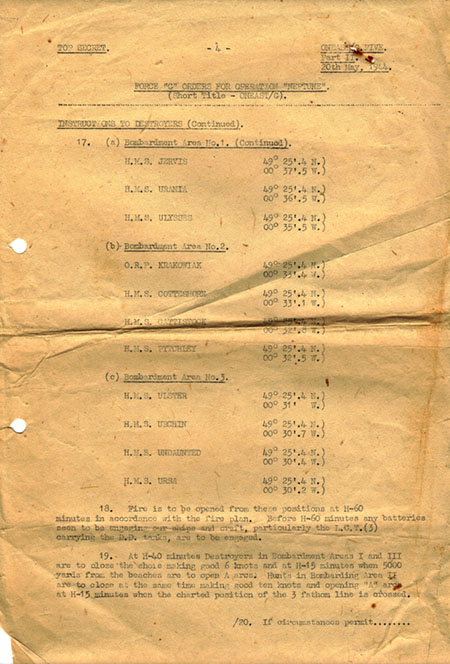A HARD FOUGHT SHIP
The
story of HMS Venomous
Lt Cdr Angus A Mackenzie RNR (1905-75)
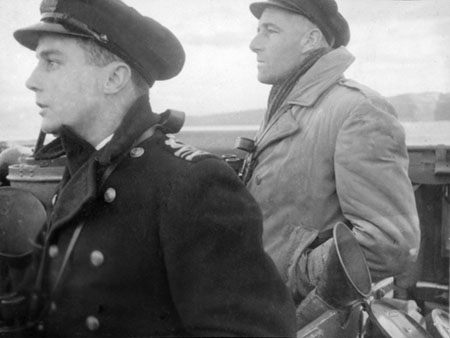
Lt Angus A Mackenzie RNR was “No.
1” on HMS Venomous
to
Lt Cdr John McBeath RN in 1940-1 (Mackenzie is on the left with McBeath on the right in Lt Peter
Kershaw's photograph). He was an outspoken officer known by
his fellow officers as “Bloodie” Mackenzie but John McBeath recognised
his seamanship and powers of leadership.
Venomous
evacuated the Welsh and Irish Guards from Boulogne and helped bring
back the BEF from Dunkirk and Mackenzie was twice Mentioned in Dispatches (MID) and promoted to
Lt Cdr before leaving Venomous to
take command of HMS Vimiera
in February 1941.
A Hard Fought Ship
covers his ten months on Venomous
but his daughter, Sheena Mackenzie, has helped me give a more
rounded picture of his service on HMS Hood before the war and his wartime service after leaving Venomous as CO of HMS Vimiera, Liddesdale and Undaunted which took part in the D-Day landings, in Normandy in June 1944 (Operation Neptune) as well as his post-war business career in Hong Kong and Japan.
Angus Alexander Mackenzie was
born on the 9 January 1905 in Kingston, Jamaica: “His father was with
the Manchester Regiment and my grandmother joined him there. She lived
in the barracks during the great earthquake in Jamaica. They thought
she was ‘tetched’ after delivering because she insisted on remaining
under the table with the baby, then came the earthquake." The family returned home before the war and lived in Perth: "My
grandfather, Capt. Angus McKenzie, MC & Bar, was killed in the
dying days of WWI at the same time as Wilfred Owen, they are both
buried at Ors, in France.”
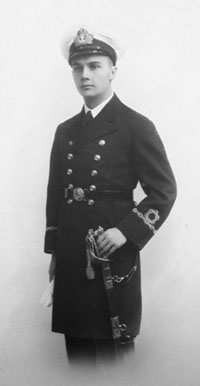 Angus Mackenzie was seventeen when he went to sea as an apprentice in 1922: “my
father always signed himself Mackenzie – small k – that was how it was
written [by the clerk] when he signed on as an apprentice [with the Cairn Line] when he first
went to sea and why he never used McKenzie.”
He was only 5ft 4inches high with brown hair and brown eyes. He
completed his five year apprenticeship with the Cairn Line on the 22
June 1926 and this studio photograph was taken. The first
entry in his seaman's Certificate of Discharge (R7873) is on the 28 December when he joined the SS Cairnesk as 3rd Mate. He remained with the Cairn Line on Cairnesk's regular run to the USA or Canada until February 1928 when he took two months' leave before joining SS Benrinnes, part of the Benn Line, at Sunderland on the 1 May. He left the Benrinnes after two voyages at Middlesborough in March 1929.
Angus Mackenzie was seventeen when he went to sea as an apprentice in 1922: “my
father always signed himself Mackenzie – small k – that was how it was
written [by the clerk] when he signed on as an apprentice [with the Cairn Line] when he first
went to sea and why he never used McKenzie.”
He was only 5ft 4inches high with brown hair and brown eyes. He
completed his five year apprenticeship with the Cairn Line on the 22
June 1926 and this studio photograph was taken. The first
entry in his seaman's Certificate of Discharge (R7873) is on the 28 December when he joined the SS Cairnesk as 3rd Mate. He remained with the Cairn Line on Cairnesk's regular run to the USA or Canada until February 1928 when he took two months' leave before joining SS Benrinnes, part of the Benn Line, at Sunderland on the 1 May. He left the Benrinnes after two voyages at Middlesborough in March 1929.
In September the Wall Street Crash brought about a slump in world trade
and ushered in the Great Depression and there are no more entries in
his Certificate of Discharge until he joined the Bibby Line's MV Gloucestershire
in March 1932. With half the merchant fleet laid up it was probably
impossible for him to get a ship. He may, like my own father who was
also RNR, have been reduced to taking a job on an Antarctic whaler
since his daughter recalls him remarking that whale meat served fresh
was not as unpalatable as it was thought in wartime Britain. He also
had the time to study for his "ticket". He passed the Board of Trade
examination at Dundee on the 22 September 1930 and on the 3
October was issued with his Certificate of Competency (No. 29481) to
serve as "Master".
On the 3 June 1932 he joined MV Gloucestershire
as 4th Officer at Liverpool where the
ship's owner, Bibby Line, had its Head Office. It was a well
known company with a good reputation for
looking after its staff and he was to remain with
them until he was mobilised to serve in the Royal Navy at the outbreak
of war. Now that he had his "ticket" to serve as Master and a secure
job with a good firm he was able to get married. His wife, Dorothy
Harding, was from
Plymouth where her parents owned Charles Harding Furniture. On the 25
August 1932 they eloped and married in secret in the Registry Office as
her parents were not at all happy about their daughter marrying an
officer in the merchant marine. They were, however, soon reconciled to
the
marriage and their children grew up at Cresswell, their family home, a
villa
with stables and a chauffeur driven limousine.
He served on several of its fleet of cargo
liners including the Staffordshire, Cheshire and Somerset.
They mainly ran from Liverpool to Rangoon, a round voyage of about
three months, and the company had a government contract for carrying
troops. He was never to serve as Master – the highest rank he achieved
was 2nd Officer – but when he joined the Royal Navy Reserve the company
gave him their support.
HMS Hood
HMS Hood with Gibraltar in the background
Angus Mackenzie commissioned this painting by the marine artist,
Eric Tufnell, after the war
Angus Mackenzie joined the RNR in 1931 and
completed the usual training courses and short periods at sea on naval
vessels in 1932 and 1934 but from the 7 December 1935 to the 8
September 1936 he was on "temporary service" aboard the battleship HMS Hood. Hood had been built in the same Clyde shipyard as Venomous in 1919 and was sighted by Venomous the day before she was sunk by the Bismarck
on the 24 May 1941.
He joined Hood when it was in
the Mediterranean, based at Gibraltar. Mussolini's invasion of Ethiopia
forced the Emporor Haile Selassie to leave his country and he visited
HMS Hood at Gibraltar on the
30 May before going into exile in England. Twenty five years later
Mackenzie was invited to meet the Emporor during a state visit to Japan
which suggests they had already met aboard HMS Hood.
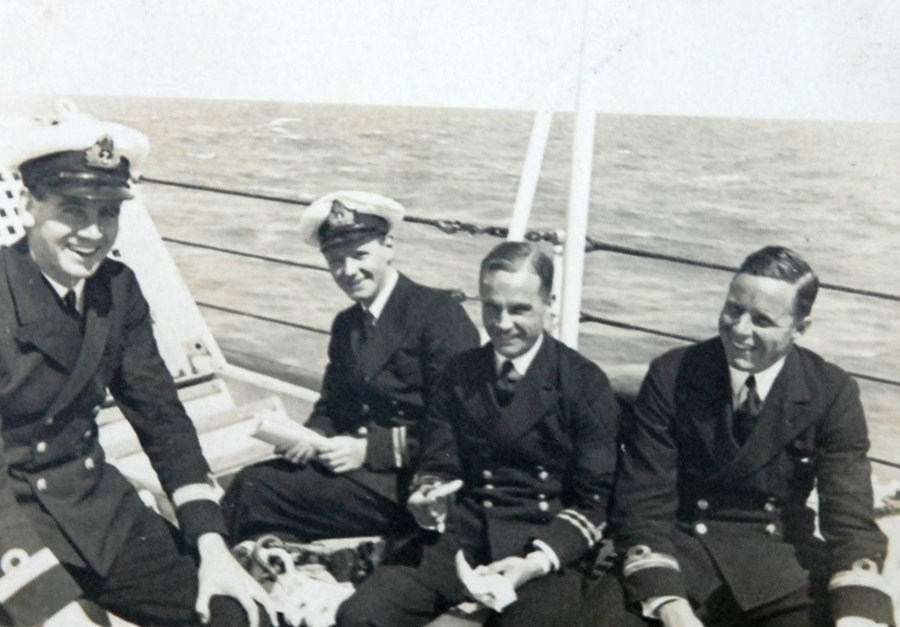 From left to right: "Hendy, Dover, Mac and Steve"
From left to right: "Hendy, Dover, Mac and Steve"
Sheena Mackenzie commented that her father lost his hair
by the age of thirty so it seems reasonable to assume that this
photograph was taken while "Mac" was serving on HMS Hood
The "flimsie" completed by Captain A.F. Pridham RN
when Lt A.A. Mackenzie RNR, "Top Divisional Officer and Turret
Officer", left Hood concluded: "A special report on this officer's
outstanding valuable service in this ship has been made to the
Admiralty. Possesses high qualities as a seaman and a leader of men.
Popular with his brother officers." What were these "special services" which merited a report to the Admiralty?
After leaving HMS Hood Mackenzie spent four months on HMS Whitshed, a V & W Class destroyer, a sister ship to Venomous
and was then sent on a signals course at Portsmouth followed by torpedo
and gunnery courses at Devonport. By the time he rejoined the Bibby
Line in March 1937 after fifteen months continuous service he was a
highly trained and very capable naval officer.
HMS Venomous
On the 9 September 1939, six days after the declaration of war, Mackenzie was posted "on mobilised service" as First Lt of HMS Goodwin,
a converted coastal cargo ship escorting east coast convoys. So short
was the Navy of suitable convoy escorts, that the Goodwin was often the
sole escort for a merchant ship convoy.
Seven months later on the 18 April 1940 he joined McBeath on HMS Venomous, just in time for Boulogne and Dunkirk.
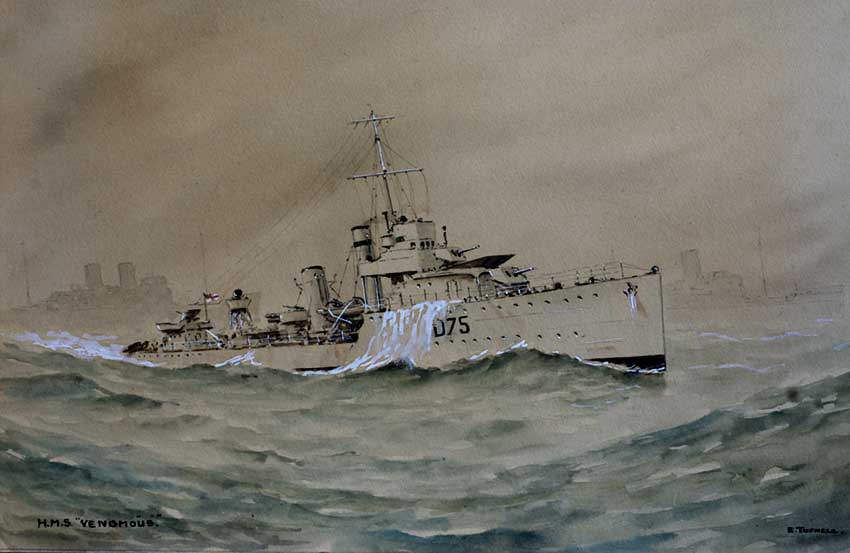
HMS Venomous as an Atlantic escort
Angus Mackenzie commissioned this painting by the marine artist,
Eric Tufnell, after the war
The following signals from V.A.D. (Vice Admiral Destroyers) Dover, found by his
daughter amongst Lt Cdr Angus A. Mackenzie's private papers, congratulated the
destroyers on the successful evacuation of the Welsh and Irish Guards from Boulogne on the 23 May 1940:
"I
wish to express my admiration of the manner in which the destroyers
attached to the Dover Command carried out the difficult operation of
evacuating the troops from Boulogne both in the face of heavy air
attack and point blank fire from guns, machine guns and snipers. The
handling of the ships and their armaments and the bearings of the
ships' companies was beyond all praise. The following received from the
CiC WA. Army's thanks to your people for last nights magnificent effort
at Boulogne." 1352/24/5/40.
It contained a footnote from CiC W.A. (Commander in Chief Western Approaches):
"We are all proud to welcome you to Plymouth after your splendid work." 1306/25/5/40
Events at Boulogne wheere HMS Venomous
and her sister V&W Class destroyers evacuated the Welsh and Irish
Guards under close range fire from shore batteries and tanks are
described in detail in A Hard Fought Ship but you can read about the part played by HMS Vimy, commanded by Lt Cdr Colin Donald RN (who had served on Venomous between the wars) and that of HMS Vimiera, the last ship to leave the harbour city, on this web site.
This photograph from the papers of Angus Mackenzie was probably taken on Venomous by Lt Peter Kershaw RNVR in May 1940
Second from right holding the edge of the parachute of a downded German pilot is Signalman O.C. Mayland
A further undated pencil written signal form in her father's personal
papers from the "V.A.D." to "Destroyers" is clearly about the evacuation of troops from Dunkirk:
"I
hoped and believed that last night would see us through but the French
who were covering the retirement of the British rearguard had to repel
a strong German attack so were unable to send their troops to the pier
in time to be embarked. We can't leave our allies in the lurch and I
must call on all officers and men detailed for further evacuation
tonight to let the world see that we never let our allies down.
Approach will be made later and retirement earlier. The night
protection of our fighters which stopped all bombing on the harbour
last night will be repeated." 10.09.
A further message received at 10.52 reads:
"The
final evacuation is staged for tonight and the nation looks to the Navy
to see this through. I want every ship to report as soon as
possible whether she is fit and ready to meet the call which has been made on our courage and endurance."
These two messages were sent on the morning of the 3 June to notify the destroyers involved in Operation Dynamo that the evacuation of troops from Dunkirk would be extended for a further night. At 0235 on the morning of the 4 June Venomous left Dunkirk for the last time with 1,100 French troops aboard.
Both these operations are described in detail in A Hard Fought Ship and will not be repeated here
On the 18 December 1940 Venomous was
transferred from Nore Command to Western Approaches and joined the
First Escort Group at Londonderry. Eric Tufnell's painting of Venomous
escorting a convoy relates to this period. In 1971 Mackenzie visited
his daughter Sheena at Halifax, Nova Scotia, and looking down on Beford
Basin from the newly built bridge across the narrows recalled how
different it was when he called in to collect a west bound convoy. It
was so packed with ships that one could get ashore by walking from ship
to ship. Venomous usually
only escorted the "empties" as far as Iceland but Fred Thomas, the RDF
operator, confirmed that on several occasions they made a quick dash
into Havelfjord to refuel before rejoining the convoy and continuing
westward to Nova Scotia.
Venomous was
severely damaged when it hit a mine in Liverpool Bay on the 29 December
and Mackenzie left on the 31 January 1941 while it was under repair at
Cammel Laird, Birkenhead, but did not take command of
HMS
Vimiera until the 26 February 1941. Vimiera
had accompanied Venomous,
to Boulogne to evacuate the Welsh and Irish Guards on the 23 May 1940.
HMS
Vimiera
HMS Vimiera was a V&W
Class destroyer which had been converted to an Escort Destroyer
(WAIR) with an increased anti-aircraft and anti-submarine armament as
part of the naval rearmament programme before outbreak of war in
September 1939. Between the wars she and her sister ships including HMS Venomous had enjoyed the peacetime routine of cruises, exercises and regettas as part of the Mediterranean fleet. HMS Vimiera had been the last destroyer to leave Boulogne during the evacuation of the Welsh and Irish Guards on the 23-4 May 1940 when Mackenzie was 'No 1' to John McBeath on HMS Venomous.
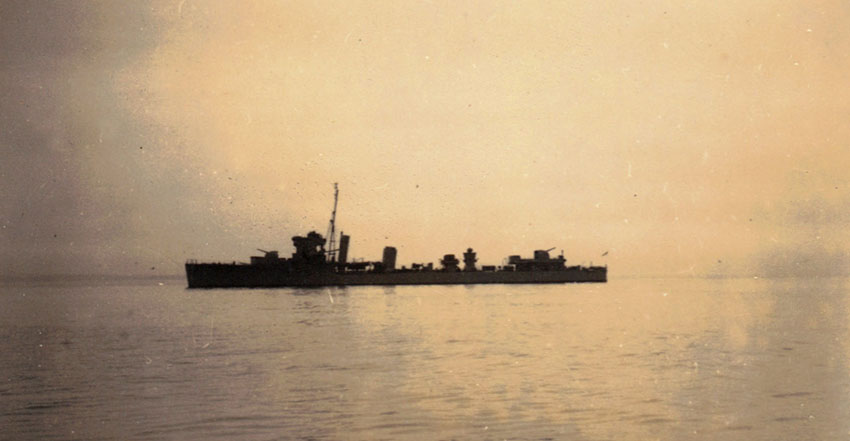
This photograph of an unidentified V & W Class destroyer with WAIR conversion is believed to be HMS Vimiera
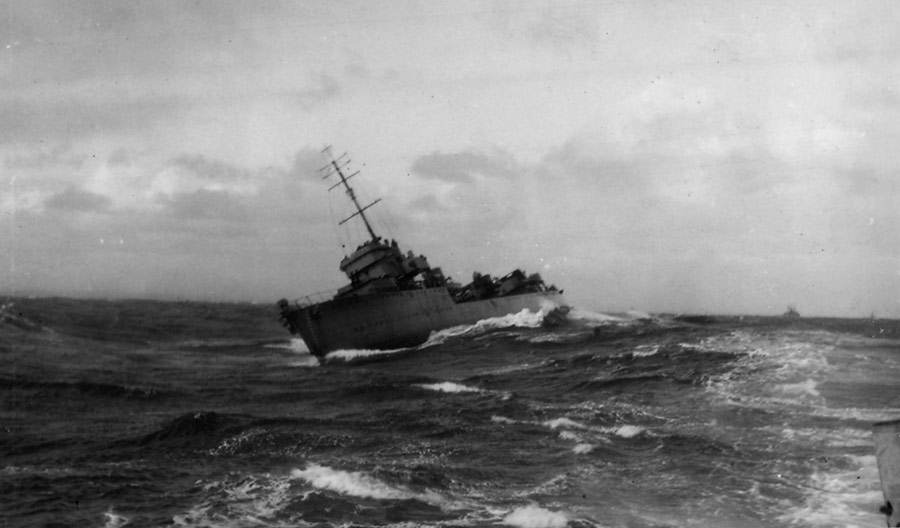
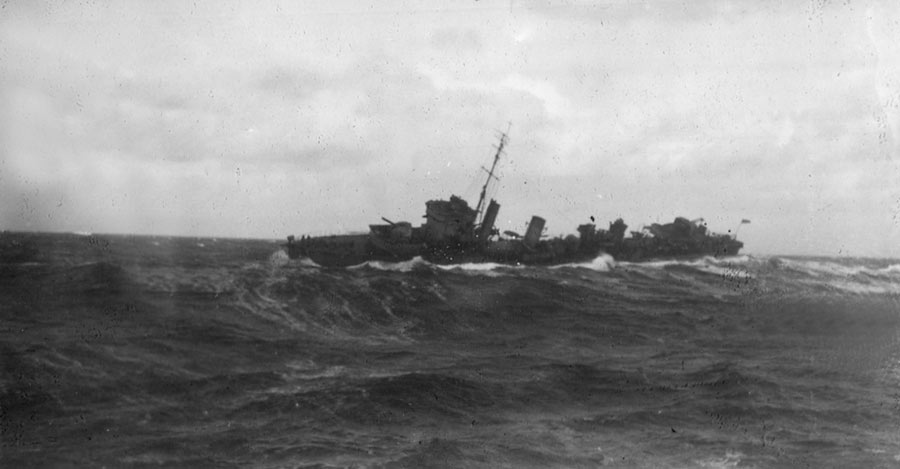 Two views of HMS Vimiera on convoy duty in rough sea between Rosyth and Sheerness
Two views of HMS Vimiera on convoy duty in rough sea between Rosyth and Sheerness
Courtesy of Paul Adams
East coast convoys were sometimes dull but Vimiera had an eventful summer:
A signal from CiCR to Valorous and Vimiera "congratulate
you both on successful beating off the attack on your convoy on August
16th. Consider you have given the Luftwaffe something to think about" (1813) and an undated signal from CiC Nore to Valorous, Vimiera and Shearwater reads "I
congratulate you on successfully protecting the convoy against a
determined air attack and on destroying 50% of attacking aircraft."
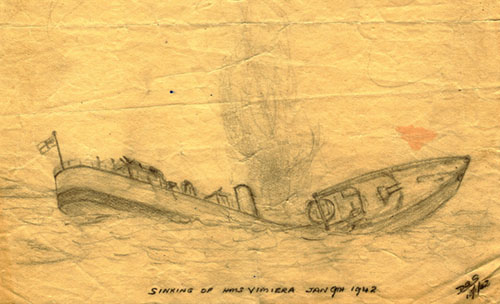
Disaster struck on Mackenzie's 37th birthday, the 9 January 1942, when HMS Vimiera
was sunk by a mine in the
Thames estuary on the southern edge of the swept channel (185 QZS)
between East Spile Buoy and J Buoy while escorting convoy FS.93
to Sheerness.
In his statement to the Board of Enquiry Mackenzie wrote that "a
violent explosion took place apparently under the after-part of the
bridge" (under the forward boiler room). The 1st Lt who was in his
cabin in the stern came on deck to see "the foc'sle about 50 yards
away, on the starboard side, standing on end, bows up, facing eastward,
the opposite direction to the rest of the ship ... the first person I
saw was the Captain, sitting on the director, with his leg dangling
over the front." The drawing done the following day by "DBS" shows the column of water and Vimiera breaking up.
Mackenzie was on the bridge at the time of the explosion but "I
regained my senses to find that I was lying by the guardrails upon the
port side of the foc'sle, which was listed about seventy degrees to
starboard. The entire forward portion of the ship had broken off
by the bridge, was being carried rapidly away by the tide and wind from
the after part, and was rapidly filling with water." Mackenzie described
how "the the forward portion now sank rapidly and air blew through the
scuttles. I had removed my inflatable life-jacket shortly before the
explosion occurred. I stripped to shirt and trousers and got into the
water to swim to the after part of the ship, which was afloat but some
distance away. I found AB Henderson, Starboard Oerlikon gunner, in the
water; he was wearing one of the new kapok overall suits, but had both
legs broken - I took him in tow. Eventualy I got hold of a line on the
starboard side of the floating portion of the ship and hung there for
some considerable time, until hauled into a Carley float by the ship's
Surgeon Lt Kidd (AB Henderson was still clinging to me and was rescued
with me). We were taken aboard Motor Minesweeper 19 and conveyed to
Sheerness."
The Board of Enquiry into the loss of HMS Vimiera was held on the 29 January in the Billiard Room of HMS Wildfire,
the shorebase at Sheerness, and most of the survivors were required to
give evidence along with the COs of nearby ships who observed the
explosion. The enquiry focused on the time of the explosion and
the position of HMS Vimiera
when the explosion occured and the height of the column of water.
Although there were differing accounts of the time (shortly after 1400)
and no conclusive evidence as to the exact position of Vimiera
the Board concluded from the violence of the explosion (the column of
water reached a height of about one hundred feet) and the position
where the two parts of the ship sank that it must have occured in
shallower water just to the south of the swept channel. Mackenzie was
not criticised by the Board of Enquiry and was soon to be given the
command of a modern Hunt Class destroyer, HMS Liddesdale.
I was sent a copy of the enquiry by Paul Adams, the son of Leading
Seaman S. Adams, one of the men awarded the BEM for crewing the whaler
which rescued men from the eight ships which ran aground on the
Haisborough Sands off the Norfolk coast on the 6 August. He was on the
forward mess deck when the mine detonated but was immensely strong and succeeded in unscrewing
an escape hatch above his head and scrambled on deck followed by two others.
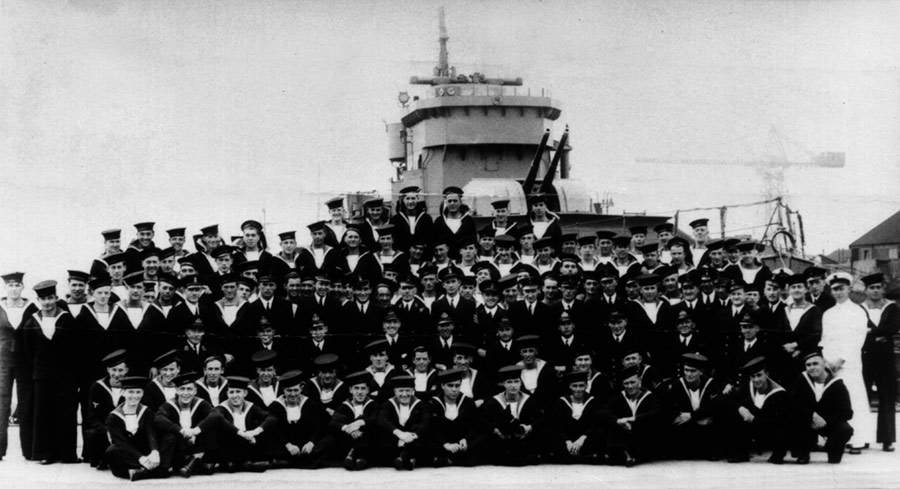 The ship's company of HMS Vimiera at Rosyth in July 1941 when Lt Cdr Angus A. Mackenzie RNR was CO
At least 59 of the 119 men in this photograph died when Vimiera detonated a mine in the Thames estuary on the 9 January 1942
The ship's company of HMS Vimiera at Rosyth in July 1941 when Lt Cdr Angus A. Mackenzie RNR was CO
At least 59 of the 119 men in this photograph died when Vimiera detonated a mine in the Thames estuary on the 9 January 1942
A key identifying the names of all the men in this photograph drawn by Lt W.R.M. Murdoch RNVR can be seen on the the web site of the V & W Destroyer Association
In
the front row are LS Stanley Aylmer Adams BEM (1920-2011) on the far
right, AB Frank Stubley (1920-2013) third from left and Robert Briggs
BEM (killed) fifth from left
Courtesy of Paul Adams
A detailed description of the disaster and the names of the 38 survivors and the 93 men who died can be seen on the website of the V & W Destroyer Association.
One man had a lucky escape.
Petty Officer James Henry Errington, one of the men awarded the BEM for
the rescue work off the Haisborough Sands, had with the Captain's
permission swopped shore leave with another PO and was at home when the
Vimiera struck the mine. He
lived with his wife at Strood in Kent and they heard the explosion. The
next day two Navy personnel arrived to advise his wife that her husband
had been killed (he was working in the garden at the time). I am
indebted to their son, also named James Errington, for this story.
“He suffered agonies over Vimiera,
he felt he lived while younger men died. He was bending over on the
bridge patting Andy his Scottish Terrier and he reckoned that was why
he was blown clear. My mother made him take Andy to sea because the dog
had a bad temper and was forever biting us – irony there! A boat was launched before Vimiera
sank and it picked up those crew members not trapped below deck or
killed in the blast including my father. The water was covered with
oil. They recognised him by the tattoos on his arms." Sheena Mackenzie
Every year
on the anniversary “he would put an announcement in the Daily Telegraph and I was
surprised how many wrote saying how much they appreciated that”
HMS
Liddesdale
Angus Mackenzie joined HMS Liddesdale
as CO on the 5 May 1942 when it was escorting east coast convoys from
Sheerness to Rosyth as described by Hal Lawrence in Tales of the North Atlantic:
“There were long periods of boredom plodding along at 8 knots with the
convoy in two columns about seven miles long going up or down the swept
channel, minefields on either side – both our own and German. The
mines, the E-boats and low flying aircraft were the main threat. The
E-boat crews were able and crafty. They used to tie up at any one of
the buoys that marked the fairway. This saved fuel and when we picked
up a radar echo we expected it to be there. Then they would start up
and roar out. They were capable mariners, brave, daring … but they had
a pretty easy target. A long line of ships parading past in pairs at
eight knots.”
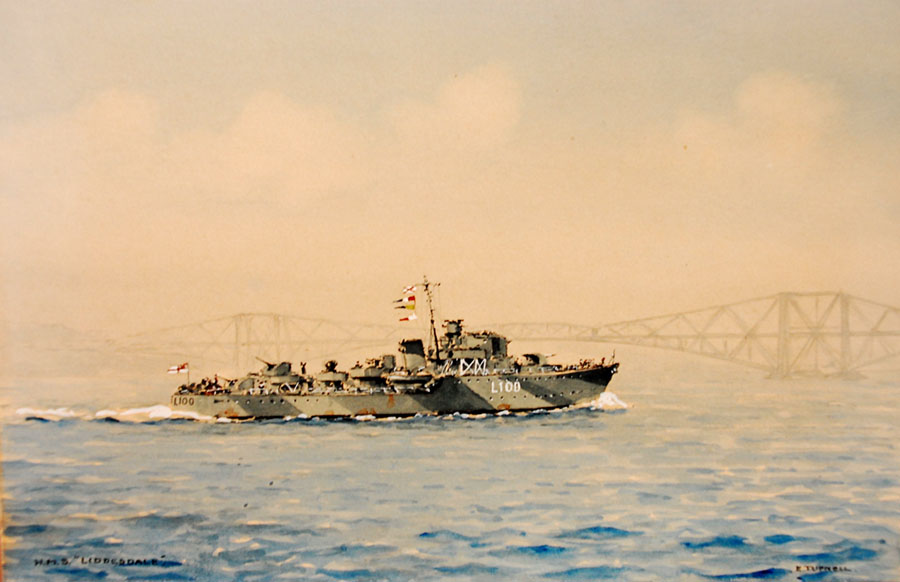 HMS Liddesdale on the Firth of Forth
Angus Mackenzie commissioned this painting by the marine artist,
Eric Tufnell, after the war
HMS Liddesdale on the Firth of Forth
Angus Mackenzie commissioned this painting by the marine artist,
Eric Tufnell, after the war
After the loss of Vimiera Mackenzie
felt unable to relax and the strain began to tell: “The Captain was on
the bridge practically the whole time. When we were returning to
Sheerness on one occasion we heard the wail of the pipes on the
forecastle. We knew the Captain played the pipes but didn’t think he
should be on the forecastle doing so when we entered harbour. The First
Lieutenant said to me, ‘Look over the bridge.’ I did. There was the
Captain playing away without any clothes on; he was naked. So our
West-Country capable First Lieutenant took the Captain gently in hand
and led him back to his cabin. He went quietly. After a rest he was
perfectly okay and went back to full duty.”
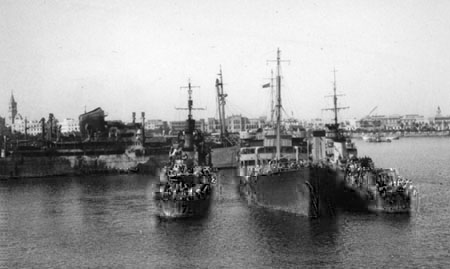
In April 1943 Liddesdale left
the east coast convoys and joined Venomous
as
part of the escort for Convoy WS.29 from the Clyde to Gibraltar.
Mackenzie saw a lot of his old ship in the next few months. In May Liddesdale and Venomous
escorted the first through convoy from Gib to Alex since the surrender
of Axis forces in north Africa (KMS.14X). They were photographed
alongside an oiler at Tripoli, the chief port in the Italian colony of
Libya, but it is unlikely that Mackenzie would have served with any of
the officers on its new commission. In July Venomous and Liddesdale escorted the troop
carriers to the invasion of Sicily, Operation Husky.
HMS Undaunted
Venomous returned to Britain in October for a major refit at
Falmouth and Mackenzie left Liddesdale
to join his next ship, HMS Undaunted,
a new U Class destroyer being built by Cammel Lairds, Birkenhead, in
time for its sea trials and commissioning into the 25th Destroyer
Flotilla.
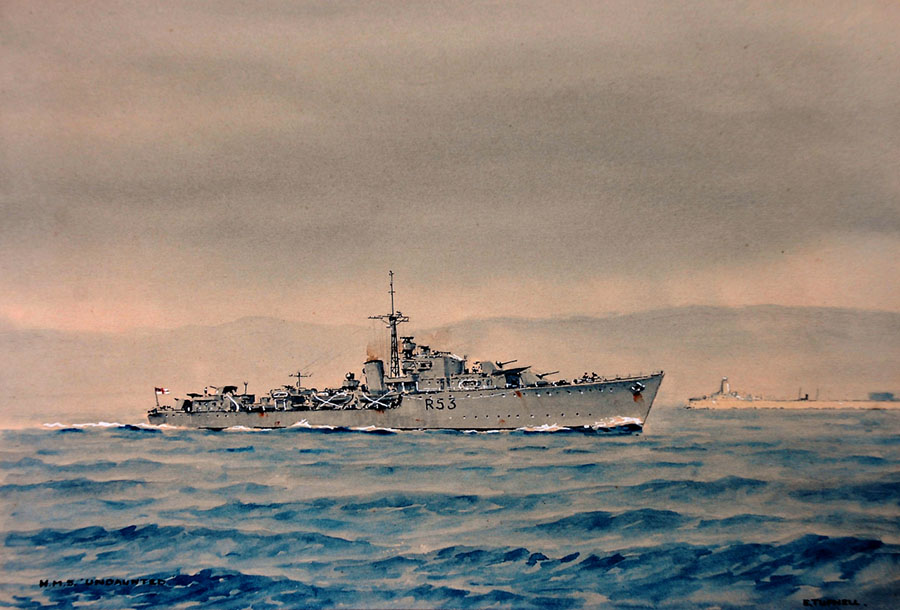 HMS Undaunted in the Mediterranean
Angus Mackenzie commissioned this painting by the marine artist,
Eric Tufnell, after the war
HMS Undaunted in the Mediterranean
Angus Mackenzie commissioned this painting by the marine artist,
Eric Tufnell, after the war
Tommy (Tug) Wilson, a stoker on Undaunted,
described events:
“For
the next ten days we did Sea Trials in Liverpool Bay and saw quite a
bit of the River Mersey. For a few days we tied up at the Pier Head,
Liverpool, by the Liver Building. When the makers handed over to the
Navy we then sailed for Scapa Flow. When in Scapa
Flow we had what they call ‘Work Ship’, to make us efficient.
Lt Michael Bray DSC RNVR who won his DSC on MTBs before joining Undaunted described Mackenzie in his memoir, One young man's war, 1939-45 (Square One, 1993):
"He
was from the Merchant Service and was an aggressive Scotsman. He
used to play the bagpipes and his big interest in life was fishing, and
later on when we were up in Scapa Flow, he used to go off in the ship's
boat endlessly, and keep his supply of worms for fishing in the
wardroom bath."
The Tirpitz,
sister ship to the Bismarck, had been confined to Altenfjord in Norway
but remained a constant menace to the British fleet and arctic convoys
to north Russia. She had been badly damaged by the midget submarine
attack in 1943 but was once again operational and Undaunted was to take part in Operation Tungsten, the latest attempt to neutralise the Tirpitz, this time with Fairy Barracuda dive bombers, as described by Stoker Wilson:
"Our first
operation, in April 1944, was with Aircraft Carriers of the Fleet Air
Arm in an attack on the Tirpitz in the Norwegian Altenfjord. We were in
the North Cape area for quite a few days. We escorted the Aircraft
Carriers HMS Furious, Victorious, Emperor, Fencer, Searcher and Pursuer
with other escorts, including HMS Anson, Belfast, Jamaica, Sheffield,
Royalist, Meteor, Milne, Onslaught, Ursa, Verulam, Vigilant, Virago and
Wakeful. We were joined by the Royal Canadian Navy ships Algonquin and
Sioux. The aircraft from the Carriers scored fourteen hits.
On our return
to Scapa we had a Concert Party aboard with ‘Jack Mills, Bernard Miles
and Party’. When going out on one operation, our Captain, a Scotsman by
the name of Angus Mackenzie, played on his bagpipes ‘Will ye no come
back again!’. We could have killed him!”
A section from "Micky Mouse" Diagram No 5, one of 20 diagrams showing the disposition of naval forces for Operation Neptune
Operation Neptune was the cross-Channel crossing phase of Operation Overlord. Operation Neptune
placed all naval issues under the command of Admiral Bertram Ramsey
whose command skill had already been seen in 1940 with the part he
played in the evacuation of troops from Dunkirk. On that occasion he
had been charged with getting the troops off the beaches, now the
requirement was to get them to the Normandy beaches on "D Day". Since
Dunkirk specialist Landing Ships had been designed and built for
landing infantry (LSI), tanks (LST) and other equipment. Ramsay had six
thousand ships under his command including four thousand landing craft,
138 warships and 287 minesweepers plus liberty ships, tugs and the
component parts of the Mulberry Harbour.
Stocker Wilson recalled the
events leading up to “D Day”:
“About
10 days before ‘D’, we sailed South and our anchorage was by the
Needles, by the Isle of Wight. Before ‘D’ day we did E-boat patrols in
the channel. We were in the forefront of the Armada on ‘D’ itself. We
were in the Roger section of Sword beach during the landings and we
bombarded the coast of France for two hours before the landings
commenced. The skipper, Commander Mackenzie stood in his Highlander's
bonnet, playing his bagpipes from the Bridge as the Landing Craft,
crammed with crouching infantry, headed past the ship towards the
beach.”
Angus Mackenzie retained the "Top Secret" orders for the bombardment of Sword beach prior to the landings:
On shore AB Sydney Compston, who had served under Mackenzie
on Venomous before
transferring to the RN Commandos, lay wounded on Sword
Beach as Lord Lovat’s personal piper “Billie” Millin walked along the
beach playing his pipes at the world’s biggest ever amphibious landing
on an enemy shore.
The following day Undaunted escorted HM Cruiser Apollo taking
General Eisenhower and Admiral B. Ramsay, Allied Naval Commander
Expeditionary Force from Portsmouth to the beachhead areas. “Tug”
Wilson described what followed:
“Eisenhower and Admiral Ramsay urged
Captain Grindle to move Apollo
closer inshore, so they could get a better view, but she hit a sand bar
and ran aground. The ships propellers were bent, and possibly the drive
shafts, in the grounding. Apollo
was refloated and limped back towards HMS Scylla, which ordered us to take
General Eisenhower and the Admiral back to Portsmouth.”
Angus Mackenzie seized the
opportunity to get General Eisenhower, Supreme Commander of the Allied
Expeditionary Force and Admiral Ramsay to sign the Wardroom's
Guest Book. His daughter, Sheena Mackenzie, sent me this scan of the
entries for the 7 June 1944:
General Eisenhower's flag was a
Wardroom “Trophy” until 1969, when it was presented to the National
Trust for Scotland during a ceremony in Edinburgh, and is now in the Eisenhower Room at Culzean Castle.
Tommy Wilson's
description of events in 1944 when Angus Mackenzie was in command can be seen on the Bolton Revisited site.
After a refit Undaunted was sent to the Mediterranean where Keith Burns joined as telegraphist and e-mailed me this account:
"She
was a wonderfully happy ship throughout my time as a member of the
crew, as a telegraphist, but my time under Lt. Cdr. Mackenzie was to be
very shortlived. When we sailed from Malta we went to the
Adriatic to do an anti submarine sweep. This was quite eventful
although we didn't encounter any subs. We picked up a family of about
six who were escaping from Yugoslavia, or was it Albania, memory
failing. They were on a small yacht with no facilities and we took them
on board. I do recall the unsuccessful effort of the Gunner(T) in
trying to sink the yacht which must have taken us a couple of hours."
Mackenzie left HMS Undaunted on the 10 October 1944 during a short refit on the Clyde and Lt. Cdr. C.E.R. Sharp took over as CO. As the focus of the war at sea moved from Europe to the war in the Pacific against Japan Undaunted was sent to join the British Pacific Fleet at Trincomalee.
HMS Undaunted remained in
service long
after the war and finally went to the ship breakers in 1974. Lt Cdr
Angus A. Mackenzie RNR (Ret), its first CO, attended its paying off
ceremony at Portsmouth after 31 years service in July 1974.
HMS
Tamar
Undaunted was Mackenzie's last command at sea. He spent the next twelve months at HMS Victory (Portsmouth), President (London) and Drake (Plymouth) before being appointed as CO at HMS Tamar, the shore base at Hong Kong, in October 1945. One of Sheena's family stories describes how soon after his arrival “he got men
and a big truck together and rounded up all the monkeys in the base
they could catch and shipped them to the other side of the island at
Repulse Bay, where their descendants still are today I hear. He had
decided something had to give because sailors had brought monkeys to HK
from more southerly parts and then left them at the base when they went
back to England. The monkeys adapted well but were getting into all the
messes and creating havoc, no more pots of marmalade laid out on the
tables etc because the monkeys swiped it all in true monkey fashion as
they had no fear of humans.”
He was soon joined
by his family as Sheena recalled: “We left from Bournemouth (I think) on the first
seaplane flight out, took a week to get to HK landing every night
and
staying in a hotel. I vaguely remember the flight, I was born in 1938
so not really that old at the time."
Post-war
Career
He was released by the
navy on the 11 July 1946 but stayed on in Hong Kong.
The revival in world trade presented an opportunity which he was
quick to recognise. He chartered ships and found the cargoes to keep
them busy.
His daughter, Sheena,
remembered that when HMS Amethyst
escaped the Yangtze in 1949:
“She entered HK harbour with her stern shot
clear through. I was sailing my little dinghy at the time and refused
to give way (I was taught ‘steam gives way to sail’) despite a voice on
a megaphone telling me to give way! By the time I stowed my dinghy at
the club and trailed up the hill to my fathers office, the Harbour
Master had called him and I was in big trouble. Looking back I realise
now my father was not entirely displeased at my adventure but when I
said ‘But you said steam gives way to sail’ he said something I have
never forgotten.”
Here lies the body of William Grey
He died maintaining his right of
way
A year or two later he moved to Japan and founded the
Hong Kong & Eastern Shipping Company and as Japan's economy revived his business prospered.
He had a contract to ship iron ore from the mines near the port of
Dungan in Malaysia and he was also instrumental in bringing to Japan
men like the Greek shipping magnate, Stavros
Niarchos, whose orders helped re-establish the
Japanese shipbuilding industry.
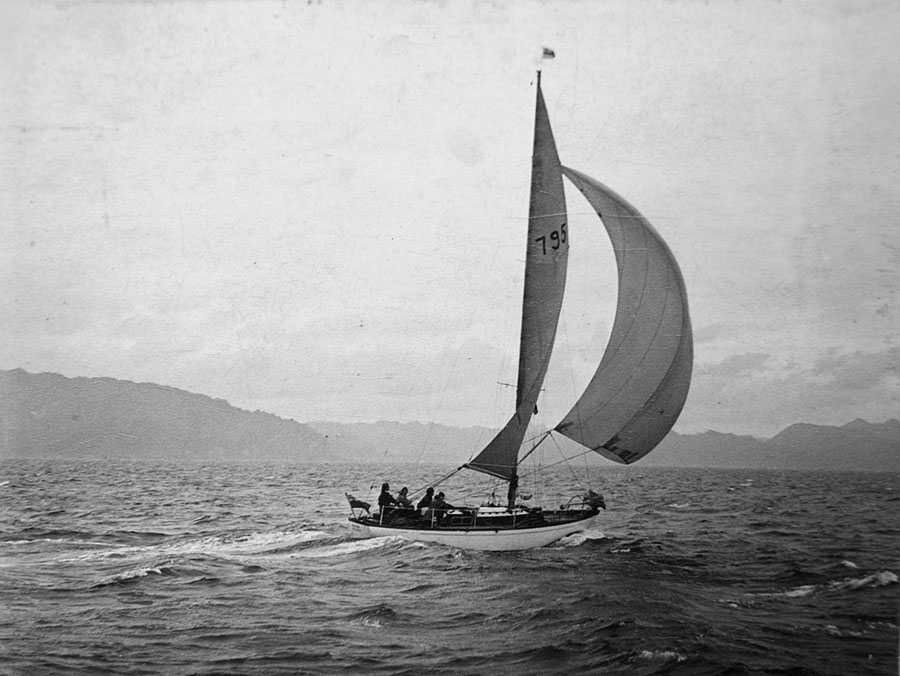 The "Skipper" at the helm of his 30ft ocean Racer, Muya, a Lion Class yacht designed by Arthur Robb of Cowes
Photographed near Oshima on the Sea of Japan in the mid fifties
The "Skipper" at the helm of his 30ft ocean Racer, Muya, a Lion Class yacht designed by Arthur Robb of Cowes
Photographed near Oshima on the Sea of Japan in the mid fifties
"The Skipper" had sailed to Japan on his yacht, sold it and had a
new Lion Class ocean racer called Muya
built at Yokohama in 1952. He sailed it with a volunteer
crew of young men and Sheena recalled that as well as being a
great piper "he was also very handy with a squeeze box, used to
entertain us on long spells at sea during ocean yacht races off Japan."
"Racing
we went hell for leather, sometimes there was muttering about too many
sail changes, but never in front of him. He felt with a full set of
sails, they should be used for the purpose intended. We were so
much faster than anyone else we wound up having to reach the finish
nearly 24 hours ahead of everyone, still it was doable."
He was a member of the Royal
Ocean Racing Club (RORC) and when in London always stayed at the RORC
clubhouse in St James Place. He had a talent for writing poetry often
with a connection to the sea
as in "Fairy Port" about an out of the way port on the Inland Sea:
Itosaki, Itosaki
Besides the Inland Sea
A rustic spot, a sylvan spot
That ever lives with me
There a hundred green-clad islands
So close around you ring
That once you have the anchor down
You'd swear there wasn't room to swing
Off Itosaki.
The family lived in Denenchofu, a suburb midway between Tokyo and Yokohama. and Mackenzie got on very well with the Japanese:
"My
father had a very nice, fair
side. His staff in Japan always referred to him as ‘father’ – we were
some of the first civilians to enter Japan after the war amidst all the
Americans. Many Japanese friends liked the way he related to them
compared to the victorious Americans. He did not hold the war
against them and that counted. He also learned the language and the way
they
thought. A Sensei [teacher] came daily to the office ahead of business
hours for half an hour. He could also write in Kanji. When we
went to live there in 1960 my eldest daughter was three and learned
Japanese in a month with the servants. That was tough for him to
take! Added to that, try as he might, he would speak to her in
Japanese and she would always answer in English. She went to a
kindergarten in Denenchofu and wound up speaking English to us but
Japanese to everybody else.
Some wealthy Japanese had fallen on hard
times and he ‘bought’ treasures from them with the intention that
they could buy them back when things were better. A loan that
saved ‘face’. I recall him sending my mother to HK on a shopping trip
with instructions to bring back a suitcase full of worm pills because
most Japanese were infested with worms and had no way to get rid of
them. He trained a pipe band for the Tokyo Police and ordered
them all kilts from Scotland – it really was a sight to see them on
parade."
When he retired in 1962 the Emperor
decorated
him with the Order of the Sacred Treasure, for “Putting Japanese
shipping on its feet”.
“After
retirement they lived in Antigua but my mother was upset by the fact
that she saw little of me and my children, so they moved to Menorca.
Never one to let the grass grow under his feet he soon became a small
time producer of fresh veggies which he sold in the market, more for
the direct contact with locals than any financial benefit, in fact my
mother maintained it was costly. He became a Honorary British Consul,
helping British Subjects who found themselves in trouble, and handling
passport renewals by British residents in Menorca and was awarded an
MBE.
When we moved to Halifax, Canada,
they came over to visit us and I would drive my father round while he
described all the places he visited when here collecting convoys. The
‘new’ bridge across the harbour had just been finished and he loved it
as it commands a wonderful view of Bedford Basin where the ships
gathered to join convoys. He said he would sail in, pick up his convoy
and go on his way.
He died in Menorca, heart attack,
at New Year 1975 and by the time I could get there, the 24 hour rule
had kicked in and he was entombed in a wall. No cremation on a small
island. Years later my cousin wrote to tell me there was now a
crematorium in Menorca and she could arrange to have his bones
cremated. When they removed the coffin, it seems the body had not
deteriorated in all those years. That caused a commotion with the
locals saying he had been distressed by being in the wall etc. So that
was how he arrived here and Bedford Basin seemed appropriate. I went
out with a friends yacht one foggy day and when the depth sounder
picked the deepest spot, we sank the ashes.
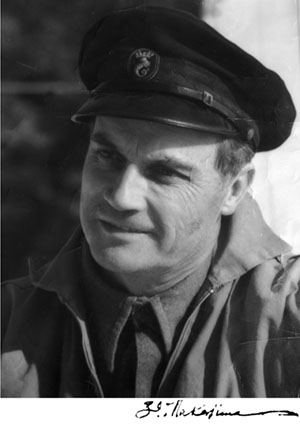
And so we lowered him slowly down
Slowly, into the bosom of his mother ocean
While rose shafts stabbed the eastern horizon
And the low-flown ensign fluttered feebly
In the lights airs of dawning
While gulls resting on the glassy swell
Lay here waiting like pilots sent from heaven
To take the souls of sailormen
We slipped the line and held our breath and watched
While he went circling through the fathoms
To his last rest near Neptune's throne
And then we spread the sails and stood away, and left him there
To his last, long watch alone.
Sea Burial by AAM
AAM with cap badge of the RORC; photographed by Nakajima
"Women always fell for him,
men respected him and I always felt blessed to have such a great
father."
Follow
in the wake of HMS Venomous
on this web site
And
find out why the "Hard Fought Ship" was "Verminous"
Buy copies of the hardback edition online from the
publisher post free for £35
Holywell House Publishing
88 Holywell Hill, St
Albans, Hertfordshire AL1 1DH, Britain
http://holywellhousepublishing.co.uk
Telephone: +44 1727 838595
contact online








 Angus Mackenzie was seventeen when he went to sea as an apprentice in 1922: “my
father always signed himself Mackenzie – small k – that was how it was
written [by the clerk] when he signed on as an apprentice [with the Cairn Line] when he first
went to sea and why he never used McKenzie.”
He was only 5ft 4inches high with brown hair and brown eyes. He
completed his five year apprenticeship with the Cairn Line on the 22
June 1926 and this studio photograph was taken. The first
entry in his seaman's Certificate of Discharge (R7873) is on the 28 December when he joined the SS Cairnesk as 3rd Mate. He remained with the Cairn Line on Cairnesk's regular run to the USA or Canada until February 1928 when he took two months' leave before joining SS Benrinnes, part of the Benn Line, at Sunderland on the 1 May. He left the Benrinnes after two voyages at Middlesborough in March 1929.
Angus Mackenzie was seventeen when he went to sea as an apprentice in 1922: “my
father always signed himself Mackenzie – small k – that was how it was
written [by the clerk] when he signed on as an apprentice [with the Cairn Line] when he first
went to sea and why he never used McKenzie.”
He was only 5ft 4inches high with brown hair and brown eyes. He
completed his five year apprenticeship with the Cairn Line on the 22
June 1926 and this studio photograph was taken. The first
entry in his seaman's Certificate of Discharge (R7873) is on the 28 December when he joined the SS Cairnesk as 3rd Mate. He remained with the Cairn Line on Cairnesk's regular run to the USA or Canada until February 1928 when he took two months' leave before joining SS Benrinnes, part of the Benn Line, at Sunderland on the 1 May. He left the Benrinnes after two voyages at Middlesborough in March 1929.